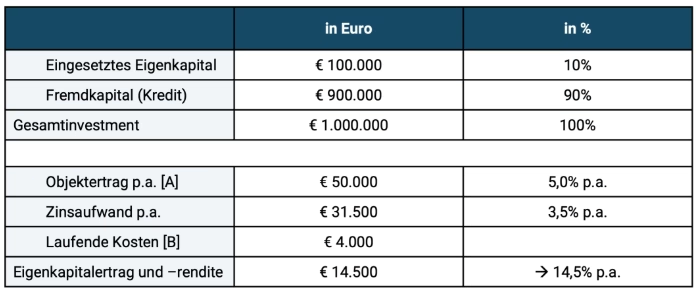A Critical Examination of Debt-Fueled Property Investment in Germany
This articles investigates the financial and risk-related implications of leveraged residential real estate investment in Germany.
While the practice of utilizing debt—known as leverage—is often portrayed as a catalyst for wealth creation, especially in property investment, an in-depth analysis reveals that the risks frequently outweigh the benefits.
Drawing on empirical studies, economic modeling, and market data, this research challenges the conventional wisdom surrounding real estate leverage and proposes a more risk-conscious approach for investors.
1. Leverage Myth in Real Estate: Introduction
Leverage in real estate investment involves financing a portion of the property with borrowed capital, thereby increasing the potential return on equity. Particularly in Germany, the appeal of leveraging in the residential housing market has grown due to historically low interest rates and the cultural preference for property ownership. Yet, while leverage can amplify returns under optimal conditions, it also increases exposure to financial risks, especially in the face of market volatility, interest rate fluctuations, and operational burdens.
This article aims to present an objective, data-driven analysis of leverage in the German real estate sector, with a focus on private investors, and to offer alternative approaches grounded in financial theory and empirical evidence.
2. Leverage Myth in Real Estate: The Mechanics of Leverage
Leverage is defined as the use of borrowed capital to increase the potential return of an investment. In real estate, this typically involves using a mortgage or other forms of debt to finance the purchase of property, thereby reducing the investor’s upfront capital contribution.
Let:
- PPP = Purchase price
- EEE = Equity
- DDD = Debt
- RRR = Return on property
- CCC = Cost of debt (interest)
Then:
Leverage Ratio=DE\text{Leverage Ratio} = \frac{D}{E}Leverage Ratio=ED
Return on Equity (ROE)=R−C⋅DE\text{Return on Equity (ROE)} = \frac{R – C \cdot D}{E}Return on Equity (ROE)=ER−C⋅D
This formula suggests that higher leverage can increase ROE if the return on property exceeds the cost of debt. However, when returns fall below financing costs, leverage magnifies losses.
Start creating wealth!
Get professional and objective advice about your finances.
3. Leverage Myth in Real Estate: Leverage in the German Housing Market
Germany has traditionally been a nation of renters, with homeownership rates at approximately 51.5% (Eurostat, 2022), lower than the EU average of around 70%. However, the period between 2010 and 2022 saw significant appreciation in urban real estate markets—Berlin, Hamburg, Munich—leading to increased interest in leveraged investments.

3.1 Property Appreciation Rates
According to the Bundesbank (2022), property prices in Germany’s top 7 cities rose by more than 85% between 2010 and 2020. This fueled speculative interest, particularly among first-time and private investors leveraging up to 90% of the property value.
However, the same data shows a sharp cooling from 2022 onwards, with nominal price declines of up to 6.8% in some urban areas as of Q4 2023 (Bundesbank, 2023).
3.2 Interest Rate Risk
The ECB increased benchmark interest rates from 0% in 2022 to 4.25% by 2024, significantly affecting mortgage affordability. For leveraged investors on variable-rate loans, monthly financing costs rose by over 40%, based on Bundesbank data. This has led to increased default risks among overleveraged buyers.
4. Leverage Myth in Real Estate: Academic Critique of the Leverage Model
4.1 Risk-Adjusted Returns
Academic literature often cautions against equating nominal gains with true investment success. The Sharpe Ratio, defined as:
Sharpe Ratio=Rp−Rfσp\text{Sharpe Ratio} = \frac{R_p – R_f}{\sigma_p}Sharpe Ratio=σpRp−Rf
(where RpR_pRp is portfolio return, RfR_fRf is the risk-free rate, and σp\sigma_pσp is portfolio standard deviation), shows that highly leveraged investments often underperform when adjusted for risk (Damodaran, 2015; Fama & French, 1992).
Several studies (e.g., Gyourko & Sinai, 2004) have shown that residential real estate, after costs, taxes, and inflation, often yields returns that are lower than equities or diversified index portfolios.
4.2 Cost Analysis
Hidden costs such as transaction fees (~10-12% in Germany), renovation, property tax, and vacancy risk erode profit margins. These are exacerbated by leverage because they reduce the equity cushion and increase sensitivity to cash flow disruptions.
5. Leverage Myth in Real Estate: Behavioral and Psychological Aspects
Overconfidence bias and the “illusion of control” are common among retail investors. Kahneman and Tversky’s Prospect Theory (1979) highlights that individuals overweight potential gains while underestimating low-probability, high-impact losses. Leveraged property investment aligns with this behavior: it offers immediate asset ownership, tax deductions, and apparent returns—while masking downside risks.
6. Leverage Myth in Real Estate: Scenario Analysis
To illustrate the long-term implications of leverage, consider two investors:
Scenario A (Leveraged):
- Property value: €500,000
- Equity: €50,000
- Debt: €450,000
- Interest rate: 3.5%
- Annual appreciation: 2%
- Net rental yield: 3%
Scenario B (Unleveraged Index Investor):
- Invests €50,000 in a global equity ETF
- Average annual return: 7% (MSCI World historical average)
- Fees: 0.3% p.a.
Over a 20-year horizon, adjusted for inflation, Scenario B yields higher risk-adjusted returns with lower volatility. The leveraged investor faces significant downside exposure in years with negative appreciation or rental disruption.
7. Leverage Myth in Real Estate: Policy and Regulatory Context
In response to the overheated housing market and rising debt levels, the German Federal Financial Supervisory Authority (BaFin) introduced macroprudential measures, including:
- Caps on loan-to-value (LTV) ratios
- Stress testing for interest rate resilience
- Increased capital buffers for mortgage lenders
These measures reflect systemic concern about the fragility of highly leveraged residential investments.
8. Leverage Myth in Real Estate: Alternative Investment Approaches
Investors looking for long-term, stable returns may consider:
- ETFs and Mutual Funds: Globally diversified equity portfolios offer inflation hedging, low fees, and liquidity.
- REITs: Exposure to real estate income with lower capital commitment and higher transparency.
- Hybrid Models: Combining equity and real estate through balanced portfolios reduces concentration risk.
9. Leverage Myth in Real Estate: Conclusion
The use of leverage in residential real estate investment is not a universally effective strategy. While it can magnify returns in bullish markets, it also increases exposure to risks that are often underestimated by individual investors. Empirical data from Germany suggests that over the long term, leveraged property investment yields lower, more volatile, and less risk-efficient outcomes than diversified equity investments.
For most private investors, particularly those lacking professional risk management capabilities, a disciplined, diversified investment approach—possibly involving a mix of low-cost ETFs and selectively managed funds—presents a more sustainable path to financial security.
References
- Bundesbank. (2023). Monthly Report – Real Estate Markets in Germany.
- DIW Berlin. (2021). Returns of Landlords in Germany 2002–2019.
- Fama, E. F., & French, K. R. (1992). The Cross-Section of Expected Stock Returns. Journal of Finance.
- Gyourko, J., & Sinai, T. (2004). Risk and Return in Real Estate Investment. NBER.
- Damodaran, A. (2015). Investment Valuation: Tools and Techniques for Determining the Value of Any Asset.
- Kahneman, D., & Tversky, A. (1979). Prospect Theory: An Analysis of Decision under Risk. Econometrica.
- Eurostat. (2022). Home Ownership Rates in Europe.
services
We help expats who want to stay in Germany long-term.
Looking for a professional financial advisor Berlin?
At Finanz2go, we provide independent, transparent advice to help you invest smart, plan your retirement, and secure your future. Our English-speaking financial advisors in Berlin are here to support expats and professionals alike.

01. investment portfolio
Start your investment portfolio
As your financial advisor in Berlin, we help you build a tailored investment portfolio aligned with your goals, risk profile, and time horizon. Our approach focuses on long-term growth, diversification, and cost-efficiency.

02. pension plan
Tax-Optimized investment plan
As your trusted financial advisor in Berlin, we help you navigate the complex German pension system and build a customized retirement strategy. We guide you in choosing the right mix of private and state-supported pension options.

03. wealth management
Personal Wealth Management
Starting from €100,000, our wealth management service offers personalized investment strategies to grow and protect your assets. As your financial advisor in Berlin, we focus on long-term planning, tax efficiency, and transparent advice tailored to your goals.
References:
- Bundesbank. (2025). Monthly Report – April 2025. Retrieved from https://www.bundesbank.de/en/press/dates/bundesbank-monthly-report-april-2025-635208
- Deutsches Institut für Wirtschaftsforschung (DIW). (2022). DIW Weekly Report 12/2022. Retrieved from https://www.diw.de/documents/publikationen/73/diw_01.c.837642.de/dwr-22-12.pdf
- Fama, E. F., & French, K. R. (1992). The Cross-Section of Expected Stock Returns. The Journal of Finance, 47(2), 427–465. Retrieved from https://www.jstor.org/stable/2329112
- Gyourko, J., & Sinai, T. (2004). Risk and Return in Real Estate Investment. NBER Working Paper No. 11094. Retrieved from [

